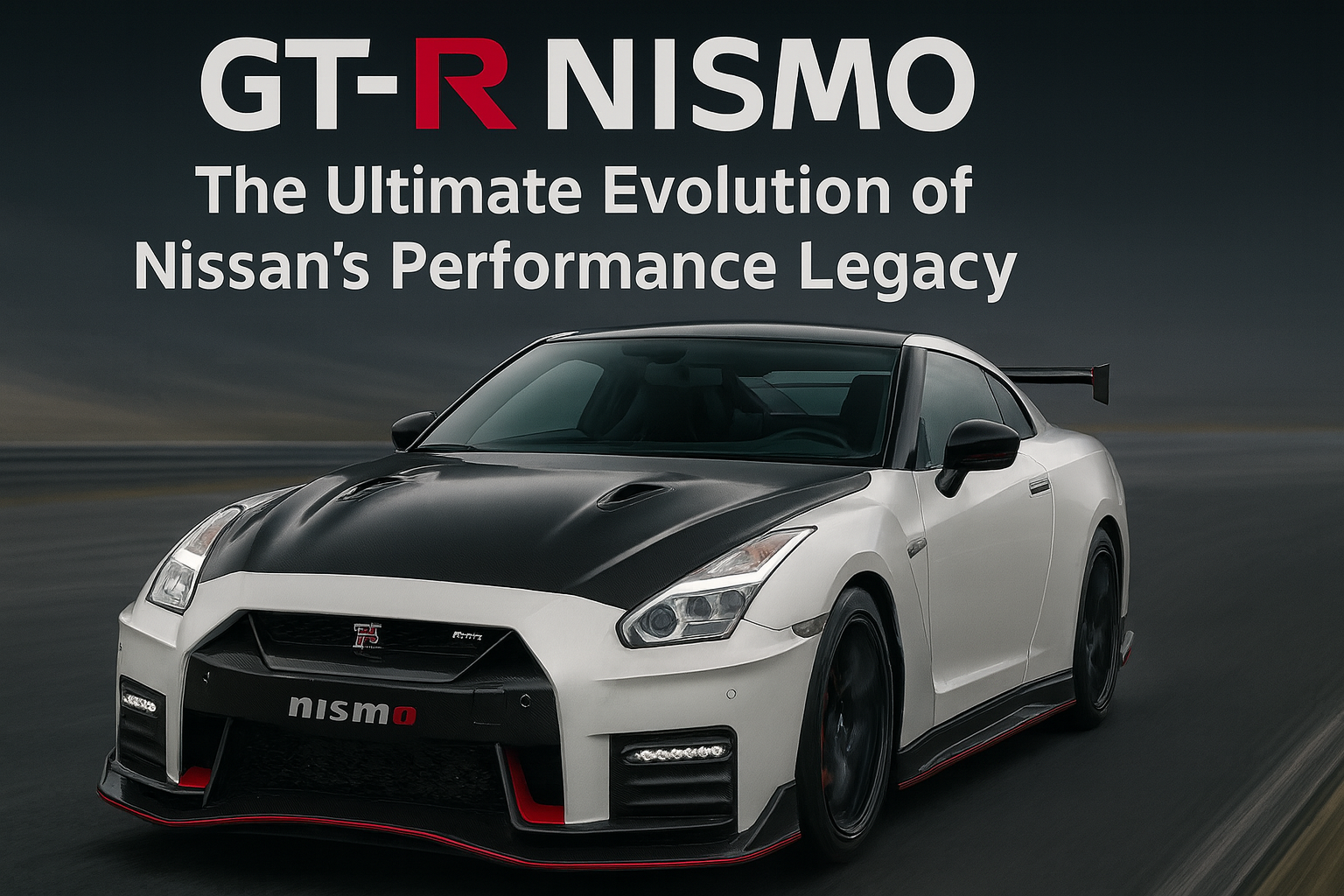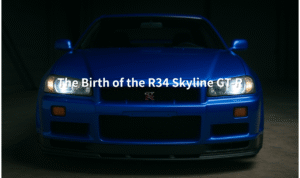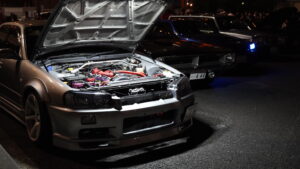Introduction
When people hear the name “GT-R,” they think of one thing above all else — speed and precision.
At the very top of that hierarchy stands GT-R NISMO, the ultimate embodiment of Nissan’s motorsport DNA.
NISMO — short for NISsan MOtorsport — was founded in 1984 as Nissan’s official motorsports division. Its mission: to bring racing technology, experience, and passion from the circuit to the road.
GT-R NISMO is the purest expression of that philosophy, designed to let drivers experience the thrill of a racing car in everyday life.
From the legendary R32 to the latest R35, NISMO has never been about tuning for numbers alone. Each model represents Nissan’s pursuit of “engineering with emotion” — where cutting-edge technology meets the human sense of control and excitement.
This article traces the evolution, technology, and philosophy of GT-R NISMO across generations, revealing how Nissan turned decades of motorsport expertise into one of the most thrilling and sophisticated road machines ever built.
1. The Birth of NISMO and the Rebirth of the GT-R (1980s–1990s)
A Brand Born from Racing
In 1984, Nissan established NISMO as a dedicated motorsports subsidiary to manage domestic and international racing programs — from Group A touring cars to Le Mans.
Its purpose wasn’t just to win races but to transfer that know-how directly into production vehicles.
R32 GT-R and the First “GT-R NISMO”
When the R32 GT-R debuted in 1989, it revived the GT-R name after a 16-year hiatus. Equipped with the RB26DETT twin-turbo inline-six and the advanced ATTESA E-TS all-wheel-drive system, it was a technological marvel.
To homologate the car for Group A racing, Nissan released a limited-run GT-R NISMO in 1990 — only 500 units were produced.
Featuring revised turbos, body reinforcement, and aerodynamic tweaks, it was a race car in road-legal form — the true origin of the GT-R NISMO lineage.
2. The R33 and R34 Era – Refinement and Technical Maturity
R33 NISMO: Stability at High Speed
The R33 GT-R, launched in 1995, emphasized high-speed stability and long-distance performance.
In 1996, NISMO created the 400R, a road-going monster with the 400-hp RB-X GT2 engine. With only 44 units built, it represented the pinnacle of R33 development — fast, refined, and brutally effective on track.
R34 NISMO: Precision and Response
By 1999, the R34 GT-R shortened its wheelbase and reduced weight, transforming into a sharper, more agile machine.
NISMO’s masterpiece came in the form of the Z-tune — only 20 cars were hand-built, each equipped with a 600-hp RB26DETT, reinforced chassis, and extensive carbon bodywork.
The Z-tune embodied NISMO’s philosophy: to bring motorsport performance to the street without compromise — a principle that would guide the future R35 NISMO.
3. The R35 NISMO – Pushing the Limits of Production Performance
The Birth of VR38DETT
With the R35’s debut in 2007, Nissan redefined the GT-R from the ground up. Its 3.8-liter twin-turbo V6, the VR38DETT, used plasma-coated bores and a rigid aluminum block for lightweight strength.
In the NISMO version, the engine was upgraded with IHI GT3-spec turbochargers, the same type used in Nissan’s GT3 race cars.
Output rose to 600 PS and 652 Nm, making it one of the world’s most powerful production V6 engines.
Drivetrain and Control
The R35 NISMO pairs the ATTESA E-TS all-wheel-drive system with the GR6 6-speed dual-clutch transmission. Together, they distribute torque instantly between the front and rear axles for maximum traction.
The 2024 model added a front mechanical LSD, improving corner-exit grip and making the car even more stable under high lateral loads.
Aerodynamics and Weight Reduction
Aerodynamics were developed through motorsport experience.
The NISMO features extensive use of carbon fiber — hood, trunk, front lip, side skirts, and a striking swan-neck carbon rear wing.
These refinements increased total downforce by 13% while minimizing drag, allowing the R35 NISMO to carve corners with surgical precision.
4. NISMO Engineering: Chassis, Suspension, and Control Systems
Reinforced Structure and Balanced Rigidity
NISMO engineers focus on balance, not stiffness alone. Strategic spot welds, reinforcement bars, and mounting point revisions enhance torsional rigidity without sacrificing ride quality.
This balance ensures that steering inputs translate instantly into chassis response — a hallmark of GT-R NISMO handling.
Suspension and Tire Integration
Each component — dampers, springs, tires, wheels — is tuned as part of one unified system.
Forged RAYS aluminum wheels and NISMO-specific tire compounds provide unmatched grip and steering feedback.
The goal is not just high limits but predictable behavior when approaching them — what test drivers call “usable performance.”
Data Meets Human Sensibility
While NISMO’s testing uses extensive telemetry, final calibration relies on human feel.
Top test drivers, known internally as “AS-rank,” refine the car’s behavior on both circuits and public roads, ensuring it delivers exhilaration and confidence in equal measure.
5. Craftsmanship and Design – Hand-Built Precision
Meticulous Assembly and Painting
Every NISMO GT-R goes through dedicated production processes distinct from standard GT-Rs.
Complex masking is performed manually to achieve the signature red accent lines and deep gloss finishes.
Each car is checked repeatedly for precision alignment — not just for aesthetics but for aerodynamic consistency.
Cockpit for the Driver
Inside, the philosophy is “no distractions, no hesitation.”
Alcantara-wrapped steering with a red center mark, and carbon-fiber Recaro seats developed exclusively for NISMO, provide optimal hold and lightness.
Even small tactile details — switch resistance, pedal travel, shifter feel — are engineered to help the driver operate instinctively at high speeds.
6. Generations of GT-R NISMO Models
| Generation | Year | Model | Key Features | Units Built |
|---|---|---|---|---|
| R32 | 1990 | GT-R NISMO | Homologation special with race turbos & aero | 500 |
| R33 | 1996 | 400R | 400-hp RB-X GT2 engine | ~44 |
| R34 | 2005 | Z-tune | 600-hp, carbon body, hand-built | 20 |
| R35 | 2014– | GT-R NISMO | 600-hp VR38DETT, GT3 turbos | Limited |
| R35 | 2024 | NISMO Special Edition | Carbon-clear hood, +13% downforce | Unannounced |
Across generations, NISMO’s essence remains unchanged: to translate racing precision into road-car reliability.
Every GT-R NISMO stands as a bridge between the racetrack and the street — fast, focused, and remarkably composed.
7. The Future of NISMO and the Next GT-R
The Path Toward Electrification
Nissan’s latest performance tech, such as e-4ORCE (dual-motor torque vectoring) and e-POWER AWD, shows the brand’s direction for an electrified future.
By fusing electric motor instant torque with fine electronic control, Nissan aims to deliver “NISMO-level excitement” in the EV era — a car that’s both fast and emotionally engaging.
The Post-R35 Era
In 2025, the R35 GT-R officially ended production after an extraordinary 18-year run.
However, Nissan confirmed that “the GT-R name will live on.”
Whether the next generation (often referred to as R36) becomes a hybrid or full EV remains undisclosed, but it’s certain that NISMO will be at the core of its development, ensuring the soul of GT-R endures
8. The NISMO Philosophy – “Performance You Can Feel”
Beyond Numbers
NISMO’s obsession has never been about achieving the fastest lap times alone.
Instead, the focus lies in creating “the quality of speed” — the seamless connection between driver, chassis, and powertrain.
From turn-in response to exit traction, NISMO cars are designed so the driver can push harder with confidence, lap after lap.
Usable Performance
Thanks to sophisticated electronics like ATTESA E-TS and adaptive transmission control, GT-R NISMO remains approachable even for non-professionals.
Modes such as SAVE, NORMAL, and R adjust drivetrain behavior to suit the road — from mountain passes to city traffic — embodying the concept of everyday supercar.
Conclusion
GT-R NISMO is not just a faster GT-R — it is the culmination of over four decades of Nissan’s motorsport spirit.
From the 1990 R32 NISMO to the final R35 Special Edition, every generation refines the same mission: to make racing-grade performance accessible and enjoyable.
Its 600-hp VR38DETT engine, GT3-derived turbos, GR6 dual-clutch transmission, and ATTESA E-TS all-wheel drive create more than raw numbers — they produce a driving experience defined by control, precision, and trust.
Even as the world transitions toward electrification, NISMO’s pursuit of “human-centered excitement” will continue through technologies like e-4ORCE and future GT-R concepts.
The essence of NISMO lies not in horsepower or lap times but in that moment when machine and driver resonate as one.
GT-R NISMO stands as both an engineering masterpiece and a symbol of Japanese craftsmanship — a legacy of speed, skill, and passion that continues to inspire the next generation of performance enthusiasts.










